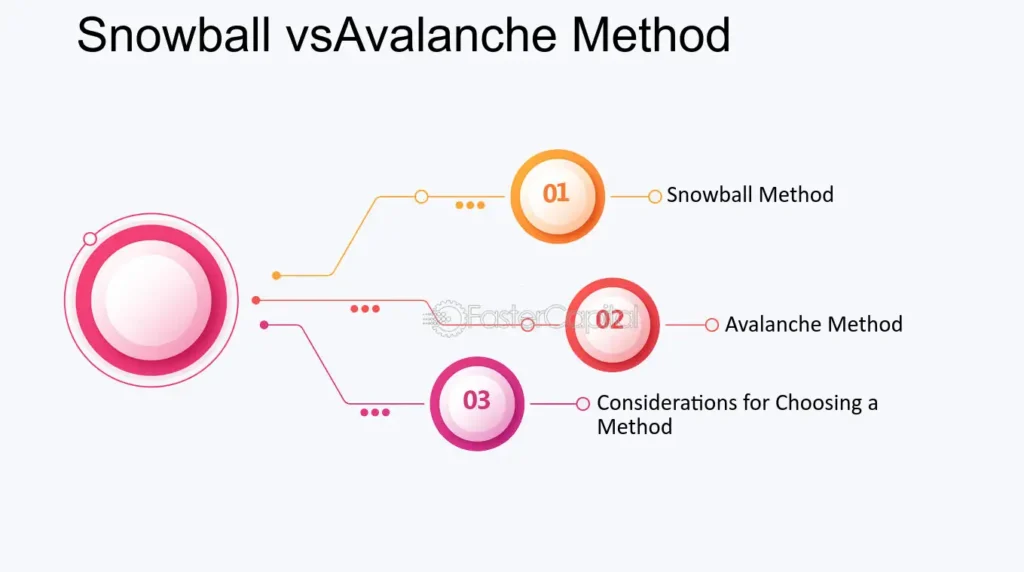Avalanche vs. Snowball – Mastering Loan Repayment Strategies
Conquering Your Debts: Avalanche vs. Snowball – Mastering Loan Repayment Strategies
Drowning in debt? You’re not alone. Millions of people struggle with managing multiple loans, credit cards, and other financial burdens. But there’s hope! Strategic debt repayment methods can help you chip away at those balances and achieve financial freedom. Two popular strategies dominating the personal finance landscape are the debt avalanche and debt snowball methods. Let’s delve into the nitty-gritty of each and help you pick the champion for your debt-slaying journey.
The Debt Avalanche: A Math Whiz’s Ally
Imagine yourself as a mathematician wielding a mighty financial calculator. The debt avalanche method is your perfect weapon. This strategy prioritizes paying off debts with the highest interest rates first. Here’s the logic: high-interest debts accrue the fastest amount of debt, so eliminating them swiftly saves you significant money in the long run.
Step-by-Step Avalanche:
- List your debts: Gather all your loans, credit cards, and any other debts you owe.
- Interest rate ring: Arrange your debts in descending order of interest rate. The debt with the nastiest interest rate sits at the top, ready for your avalanche.
- Minimum payment march: Make minimum payments on all your debts.
- Avalanche the extra: Any extra money you have goes towards the debt with the highest interest rate.
Example: Let’s Get Avalanching!
Imagine you have three credit cards:
- Card A: Balance – $1,000, Interest Rate – 18%
- Card B: Balance – $2,000, Interest Rate – 12%
- Card C: Balance – $3,000, Interest Rate – 8%
Following the avalanche method, you’d prioritize Card A despite its lower balance. The high 18% interest rate makes it the costlier debt. Once Card A is paid off, you’d roll the extra payment you were making on it towards Card B, and so on, until all cards are paid in full.

Benefits of the Debt Avalanche:
- Saves money: You end up paying less interest overall. In our example, tackling the 18% interest rate on Card A first saves you significant money compared to focusing on Card C’s lower interest rate first.
- Debt domino effect: Paying off a debt gives you a psychological boost and frees up extra money to avalanche towards the next debt, creating a snowball effect (but a mathematically calculated one!).
Drawbacks of the Debt Avalanche:
- Slow gratification: It might take longer to see a complete debt disappear compared to the snowball method. This can be discouraging for some.
- Requires discipline: Sticking to the plan and prioritizing high-interest debts over potentially smaller balances demands strong financial discipline.
The Debt Snowball: Motivation Maestro
The debt snowball method takes a different approach, focusing on paying off the smallest debts first, regardless of interest rate. This strategy prioritizes the psychological warfare against debt. Here’s the snowball’s secret weapon:
The Power of Quick Wins:
By eliminating smaller debts quickly, you experience the satisfaction of “wins” early on. This keeps you motivated and energized to tackle the bigger ones later.
Step-by-Step Snowball:
- List your debts: Similar to the avalanche, gather information on all your debts.
- Balance brawl: Arrange your debts in ascending order by balance, with the smallest debt at the top.
- Minimum payment shuffle: Make minimum payments on all your debts.
- Snowball the extra: Any extra money you have goes towards the debt with the smallest balance.
Example: Let’s Get Snowballing!
Let’s use the same credit card scenario:
- Card A: Balance – $1,000, Interest Rate – 18%
- Card B: Balance – $2,000, Interest Rate – 12%
- Card C: Balance – $3,000, Interest Rate – 8%
Using the snowball method, you’d target Card A, the one with the smallest balance. Once Card A is paid off, the psychological victory and the extra money freed up become your ammunition to snowball towards Card B, and so on.
Benefits of the Debt Snowball:
- Motivation magic: Seeing debts disappear quickly provides a powerful motivational boost to keep you on track.
- Simpler to manage: The snowball method is easier to understand and implement, making it suitable for those new to debt repayment strategies.
Drawbacks of the Debt Snowball
- Might cost more: You might end up paying more interest overall compared to the avalanche method since you’re not prioritizing the high-interest debts first.
Choosing Your Debt Repayment Champion
So, which method reigns supreme? The answer depends on your financial personality and goals. Here’s a breakdown to help you pick your champion:
Choose the Debt Avalanche if:
- You’re a numbers whiz and prioritize saving money on interest.
- You have strong financial discipline and can stay focused on the long-term goal.
- You don’t need quick wins to stay motivated.
Choose the Debt Snowball if:
- You need the psychological boost of seeing debts disappear quickly to stay motivated.
- You find the avalanche method too complex or overwhelming.
- You have a mix of small and large debts, and eliminating a small one first would be a significant win.
Hybrid Warfare: The Best of Both Worlds
Can’t decide? Why not create a hybrid strategy? Here’s how:
- Identify one or two high-interest debts and prioritize them using the avalanche method.
- For the remaining debts, focus on the snowball method, paying off the smallest balances first.
This approach gives you the benefit of saving on interest from high-interest debts while still experiencing the motivational wins of eliminating smaller ones.

Additional Tips for Debt Slaying Success
- Track your progress: Monitor your debt payments and celebrate milestones. Seeing progress is a powerful motivator.
- Cut back on expenses: Free up extra money to throw at your debts by identifying areas where you can cut back on spending. Every little bit helps!
- Increase your income: Look for ways to boost your income, whether through a side hustle or negotiating a raise. More income allows you to pay down debts faster.
- Beware of lifestyle creep: As you pay off debts, resist the urge to increase your spending. Keep your focus on staying debt-free.
The road to debt freedom might seem long, but with the right strategy and unwavering commitment, you can achieve it. Remember, the most important factor is to choose a method that works for you and stick to it!
Beyond the Basics: Advanced Debt Repayment Strategies
For those seeking to explore further, here are some advanced debt repayment strategies:
- The debt consolidation loan: This involves taking out a single loan to pay off multiple debts. It can simplify your repayment process and potentially lower your interest rate, but be mindful of the terms and conditions.
- The balance transfer: Transfer your credit card balance with a high-interest rate to a card with a lower introductory rate. This can buy you time to pay down the balance without accruing high interest, but be aware of balance transfer fees and ensure you pay off the balance before the introductory period ends.